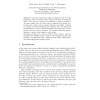Free Online Productivity Tools
i2Speak
i2Symbol
i2OCR
iTex2Img
iWeb2Print
iWeb2Shot
i2Type
iPdf2Split
iPdf2Merge
i2Bopomofo
i2Arabic
i2Style
i2Image
i2PDF
iLatex2Rtf
Sci2ools
RULES
1995
Springer
1995
Springer
Temporized and Localized Rule Sets
Constraint management plays an important role in design applications where constraints re ect design restrictions and design decisions. ECA rules are a widely used mechanism to enforce constraints. The paper argues that such rules must be augmented for design environments by a spatial and a temporal dimension of validity, resulting in so-called area-event-condition-action
AECA
rules. The spatial dimension allows to restrict constraints locally in the design space, and to control interaction between designers. The temporal dimension permits designers to retract their designs to earlier stages. The paper introduces the concept of AECA rules, motivates them by examples from building design, discusses rule management, and then introduces two important issues, con ict detection during collaboration, and backtracking during design revision.
| Added | 26 Aug 2010 |
| Updated | 26 Aug 2010 |
| Type | Conference |
| Year | 1995 |
| Where | RULES |
| Authors | Rose Sturm, Jutta A. Mülle, Peter C. Lockemann |
Comments (0)

